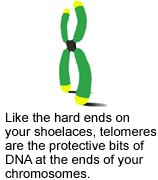This Thanksgiving, give thanks for...
your telomeres, and the telomeres of your loved ones!
Molecular biology is full of cute shit if you squint hard enough while looking at it. Being a little drunk helps too. So next time you find yourself getting a little misty-eyed while thumbing through your bio text book, a gin martini at your side, you should definitely still feel weird because most people don't engage in this type of behavior.
And that's why this Thanksgiving I will force people to share my enthusiasm for all the things that are successfully occurring in your cells, without much of your conscious input. Just keep eating and staying out of direct sunlight!
If you're still wondering what telomeres are, and why we should be thankful for them, you're probably drunk. I'll start with this graphic: So if your chromosomes were-- god forbid it-- shoelaces, then telomeres would be the aglets. And you would be a shoe.
So if your chromosomes were-- god forbid it-- shoelaces, then telomeres would be the aglets. And you would be a shoe.
Why do your chromosomes need this kind of protection? The way your DNA replicates is a bit of a struggle, and it leads to something called the "End Replication Problem." I won't go into detail, but the problem part is that each time your DNA is replicated one of the strands ends up a little bit shorter. This means that during the next round of replication, the DNA will get even shorter. Essentially, you would be losing small amounts of important genetic information every time your cells divided.
This would kind of be embarrassing, not to mention evolutionarily short-sighted, for our cells and ourselves. Hence telomeres! Telomeres are stretches of repeated non-coding DNA sequence that get added onto the gimp strand during replication. Some cell types are estimated to contain 8000 base pairs worth of telomeric repeats at birth. Because these telomeric repeats are known sequences, you can visualize them using a fluorescently labeled probe complementary to the telomere region-- in humans, the repeated sequence is TTAGGG. In the picture below, the telomeric regions are yellow and the rest of the chromosome is blue: But telomeres don't completely solve the End Replication Problem, they just delay its potentially devastating effects. Your DNA still gets shorter with every round of replication, but you're losing telomeric repeats not necessary genes. For those cells with 8000 base pairs of telomeric sequence, the number is reduced to about 1500 base pairs by the time you can collect senior citizen discounts.
But telomeres don't completely solve the End Replication Problem, they just delay its potentially devastating effects. Your DNA still gets shorter with every round of replication, but you're losing telomeric repeats not necessary genes. For those cells with 8000 base pairs of telomeric sequence, the number is reduced to about 1500 base pairs by the time you can collect senior citizen discounts.
Read more about telomeres if you have questions about how they influence aging events, but you could also just be glad they get added in the first place.
2 comments:
Positive strand and gimp strand. Brillant.
I read this at work and was immediately invigorated, saying, "YAY, TELOMERES." You made my day.
Post a Comment